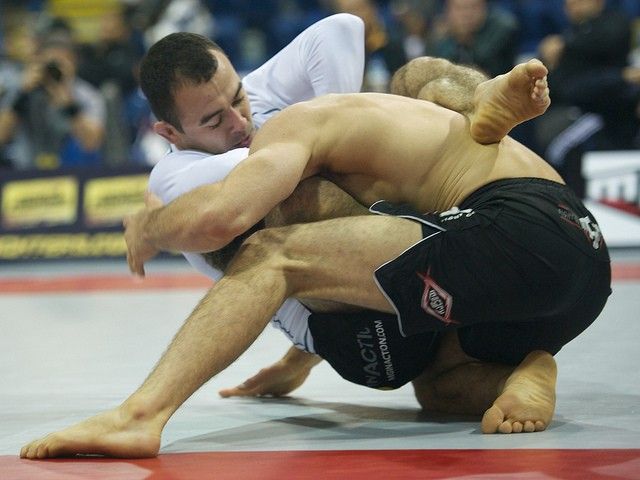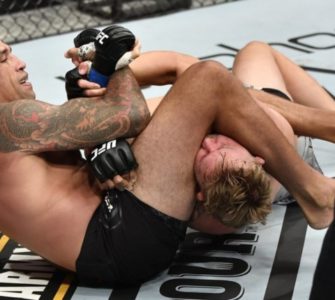Guest post by Evolve MMA, Asia’s premier championship brand for martial arts. It has the most number of World Champions on the planet. Named as the #1 ranked martial arts organization in Asia by CNN, Yahoo! Sports, FOX Sports, Evolve MMA is the top rated BJJ gym in Singapore.
For years, the age-old argument of whether or not one should train gi or no-gi has plagued many Brazilian Jiu-jitsu practitioners.
However, many BJJ world champions believe that deciding on one or the other shouldn’t be a factor in training Brazilian Jiu-Jitsu. In fact, one of the most decorated gi and no-gi champions, Marcelo Garcia trains in both. “I train everyday in the gi, and once a week with no-gi. An athlete who wants to be good in no-gi, must also train in the gi,” says Marcelo.
The multiple world champion confirms it. In order to become a more complete grappler, you must do both.
Evolve Daily reveals why:
1) You’ll learn how to apply crazy pressure (no-gi).
Every BJJ practitioner knows the importance of putting pressure on your opponent at all times. Whether it’s to get a more advantageous position, passing the guard or even pulling a submission, pressure must be applied at all times to fully secure your next move.
According to BJJ World Champion and ONE Championship superstar Herbert Burns, because you don’t have any material to rely on in no-gi, you become more aware of your opponent’s anatomy and what it takes to get them to react a certain way. Pressure becomes even more of an important factor because you need to know where to put your weight to give you the upper hand in the match.
This translates seamlessly into any gi game, which also uses pressure to control the opponent at all times with the added bonus of having a collar or sleeve or pant leg to pin your opponent down with.
2) You’ll develop quick reflexes (no-gi).
Every martial artist knows the value of making a technique a reflex. We work on and drill a certain move in order to make it seamless when executing it during sparring or even just doing specific training in class. Knowing that you’ve perfected a technique gives you the confidence to execute it whenever you want to, without hesitation.
With the explosiveness of no-gi, you’ll have no choice but to react quickly to whatever your opponent chooses to do. There’s no time to wait and think about what move to do next, it has to become instinct. This opens your gi game to many possibilities thanks to the amount of technique you’ve made instinctive.
3) You’ll develop crazy grips (gi).
Having strong grips is paramount for any BJJ practitioner, regardless of whether they train in the gi or not. Grips are used to control opponents and stabilize positions and could even determine whether or not one will be able to win a match.
When training with the gi, strong grips are developed from all the pulling and pinning action on the pants, sleeves and collar. Although there is no material to pull in no-gi, grips are needed as well to control different joints. The grip strength you develop from gi training will undoubtedly add to the power in your grips for no-gi.
4) You’ll have excellent escapes (gi).
Being able to escape from a submission and a bad position is a skill in itself. There’s no doubt that the better you become in escaping, the more confident you’ll feel about attacking and countering because regaining control and position is no problem for you.
The friction from the gi makes escaping more difficult. At any point in time, your opponent can use their gi or yours to control and keep you from getting into a good position. This helps develop your escapes for no-gi. Because you’re so used to someone gripping your gi with full force, slipping out to escape shouldn’t be a problem.
5) You’ll have a deeper knowledge of BJJ techniques (gi).
The game of human chess will be substantially easier if you have a full arsenal of technical knowledge. Staying a step ahead of your opponent is only possible if you know what they are going to do next.
According to BJJ No-gi World Champion Bruno Pucci, training in the gi helped him refine his technical skills. In fact, he believes that in order to develop a solid base of BJJ techniques, one must train in the gi first. With the amount of techniques you learn in gi-based Brazilian Jiu-Jitsu, there’s no doubt that it will be easier to transition to no-gi afterwards.
6) You’ll be well prepared in any self-defense scenario.
Although BJJ as a whole teaches you how to defend yourself against an attacker, the chances of him wearing a gi are very slim. With that being said, you can also use the skills you’ve learned in your gi training, just in case your attacker is wearing a shirt or a jacket.
The patience and control you learn from training in the gi will help you calm down and think about what move to use in a precarious situation. The explosive power and pressure you learn from no-gi no doubt helps as well.
7) You’ll have the most well-rounded takedown game for BJJ.
Takedowns often predict who ends up in a more dominant position for the rest of the match. When training with the gi, most practitioners will attempt Judo takedowns, which mainly requires sleeve and collar control and grip fighting. In no-gi, more wrestling takedowns are used, relying on explosiveness and pressure to throw their opponents off balance.
The more knowledgeable you are about different kinds of takedowns, regardless of whether you train gi or no-gi the more it will work to your advantage. In fact, both Judo and wrestling takedowns can be used interchangeably in no-gi and gi.
Instead of choosing to train either gi or no-gi, why not do both? As you can see, both styles complement each other and are necessary for overall improvement as a grappler. Remember, in the end, it is you who makes the decision to hinder yourself from becoming a complete grappler. Why not unleash your potential and start training both styles today?

















